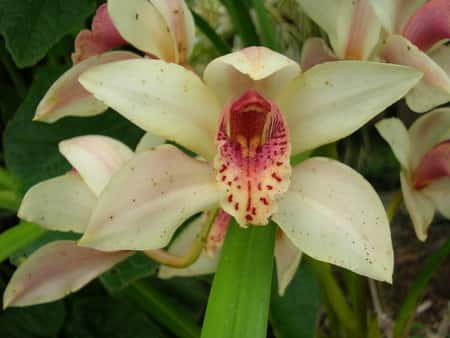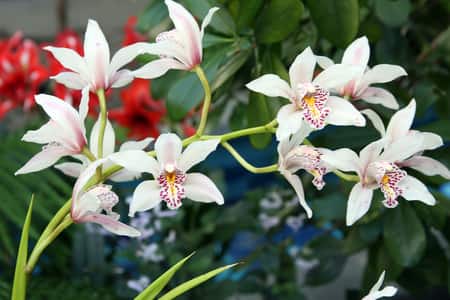Cymbidiums are one group of orchids that are different from the rest of the orchids: they thrive outside for most of the year. Most all other orchids prefer being inside (depending on your climate).
During spring, summer, and fall, cymbidiums will grow well outside, as long as the temperature is above 58ᵒ F (12ᵒ C). They are extremely easy to care for, but one thing confuses most new cymbidium growers: how do you water cymbidium orchids?
Since cymbidiums are grown outside, they will need to be watered three to four times a week, depending on how dry your climate is. Water your cymbidium orchid in the morning with the garden hose, until water leaks out the bottom. Be sure to rotate the pot, so all sides of the potting media will receive water.
Another method of watering your cymbidium orchid is to take the pot to the bathtub, and dunk it in the water until the entire pot is drenched.They tend to being on the bigger side pot-wise, so taking them to the sink is out of the question.

1) How Much Water Do Cymbidiums Like?
Cymbidiums like to be damp, but never soggy. It’s a fine line, easy to cross either way. They prefer more water than you usually provide for your Phalaenopsis. So, if you water your Phals once every week, aim to water the Cymbidium once every three days, or twice a week.
Of course, this is a general answer. It will all depend on where you live, what is in your potting media, how well the water drains, and so on.
One method that works well to see if the potting media is moist but not soggy is inserting a bamboo skewer in the middle of the pot. (Don’t aim for the sides of the pot, since more roots are on the sides and you’ll rupture one.) Keep the skewer in for five minutes, then pull it out. If the top part of your media is wet, it will show on the skewer.
Popsicle sticks also work for this, depending on how deep your pot is. This article on bamboo skewers explain more in detail how this method works.
Your aim is for the pot to be 50% dry and 50% wet most the time.
Another method is inserting your finger an inch below the top of the potting media. The surface should be dry. If it’s moist, hold back on watering. At an inch from the top, your finger should start to feel the moisture.
2) Do the Seasons Interfere with Watering a Cymbidium?
Cymbidiums growth period will be during spring, summer, and fall. In winter they bloom, yet in most climates, will have to be brought inside.
During growth, they’ll need the maximum water they can get, especially during spring and summer. Make sure that during the hottest summer months, they receive more water, even more than autumn and spring. In autumn, you can reduce watering. During the winter, when you bring them indoors, you can water less, almost down to a heavy misting.
3) Can Cymbidium Leaves Get Wet?
Yes, Cymbidium leaves can get wet, more so than Phalaenopsis. Sprinkle water over the leaves when you water in the morning, since this will also help raise overall humidity. Just be careful not to water-log the leaves, since that only induces problems. A thin mist in the morning is all they need, apart from watering.
Cymbidiums will prefer 40 to 60% relative Humidity (rH) so if you see that the leaves are wilting and look half-dead, add a humidity tray under the pot, and increase misting in the morning and at night.
Another reason to sprinkle Cymbidium leaves with water is to lower their temperature at night. If your orchid does sit in a place where daytime and nighttime temperatures don’t drop that much, you’re probably going to want to mist the orchid leaves again at night. This is not to provide water, but to induce the temperature drop of 15 degrees, which is necessary for spikes to form.

Accumulated heat gets trapped inside the leaves, and they might not cool down properly at night. If you touch the leaves around evening and they still feel hot or warm, mist them again until they’re cool. Only do this near early fall to induce the production of flower spikes.
4) Can You Kill a Cymbidium by Over Watering?
Absolutely. Over watering is the number one reason that most Cymbidiums die.
Over watering isn’t that too much water was given at one particular time. Over watering is not enough time to dry out in between watering. The media is still wet and doesn’t have time to dry out, initiating a long horrible process that leads to root decay.
When you water, maintain the hose on the plant for a long time and fully drench the media (or make sure the entire pot is dunked in the tub). Many new orchid growers will water their orchid on the correct days, but don’t apply as much water as they should when watering.
This will cause the root in the middle of the pot to die, leading to leaves that fall off. Your plant will become bare in the middle.
5) Do General Guides About Watering Cymbidiums Work?
In the guide that comes with most cymbidiums, there is a general rule: water once a week. This information is erroneous and misleading.
You will have to test your environment, since each zone is different. Where you place your orchid outside also has a difference. What is in the potting medium will interfere with how much water is retained, so that also has a variable. So, it’s nearly impossible to set down a general rule and abide by it.
If you are new to growing Cymbidiums (or other orchids for that matter) you’ll have to test your area and your watering preferences. Chose a method that works for you, and stick to it.If you want to know more about water orchids in general, I suggest this article that I wrote.
Always observe the roots and leaves, because these will be the first to indicate whether the routine you have set up is enough, too much, or perfect.
6) Can I Use Ice Cubes to Water a Cymbidium?
No, no, and no again. Never use ice cubes to water an orchid—any orchid. There’s a brand name of orchids that uses this method to teach how to water orchids, but ignore that.
Even though there was one, may I repeat, ONE, study that has proven that the temperature of the ice cube when melted, doesn’t harm the roots by the time it infiltrates the potting medium, there are other considerations that aren’t coming into the picture.
First, ice cubes come in various shapes and sizes. My ice cubes might be humongous, while other ice cubes could be tiny. How much water is three ice cubes exactly?
Second, ice cubes only dampen the area they are on. Water doesn’t reach the vast part of the pot, and the roots will dehydrate. To water well, you need to water all sides of the potting media.
Third, the ice doesn’t reach the roots at freezer-burning temperatures, but never the less, the water is cold. Temperature shock is never good for roots. The water should be at room temperature, not more, not less. The cold temperature will damage part of the velamen on the roots, but not all. This is where the article fails, because even though they state that no harm is done, they just indicate that because the orchid didn’t die. Well, it’s sure damaged.
Fourth, the size of the pot never comes into consideration. Do you have a mini Phalaenopsis? How in the world do you fit three ice cubes on that pot? What about a 12-inch pot for Cymbidiums? Will just three ice cubes give the orchid what it needs in terms of water supply?
So… Ice cubes just doesn’t cut it for me. I’ve known personally several orchid growers who defend this method, but I will not. Do what works for you, but in my opinion, stay away from ice cubes.I made a video about watering orchids with ice cubes which that you can watch here , or you can read the article about it by clicking here.
, or you can read the article about it by clicking here.
Don’t Stop Learning!
If you want to be included in more information and get a 14-page fertilization guide, please sign up for my newsletter. I don’t spam, but send emails out bi-monthly with some curious topics of interest. If you want more information, click here to go to a specific page on this website where I explain it more in detail.

Also, if you are looking for an orchid journal to keep your notes specifically about orchid care, check out my 2 solutions for that on this page. If note-keeping isn’t your thing, then there is a free excel spreadsheet that you can download. Click here for more information on how to do that.
If you subscribe to my newsletter, I will send you a 14-page guide on the main tips of orchid fertilizer. It is downloadable and you can print it out on your computer. I designed the guide to double up as a coloring book, just to make it fun.
If you have any other questions about Cymbidiums, leave them in the comments below and we’ll get back to you as soon as we can.If you want more information on Cymbidium Care, check out this complete guide.
Happy Cultivating!


Hi Amanda
I tried the ice cubes on one orchid trying to stay away from the aerial roots( you know…simple common sense) but mayb in the melting process or it got bumped, a cube got next to a young new growth and it died. So ice cubes…no bueno. Great article!!